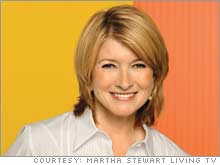 |
 |
| MSLO founder Martha Stewart |
|
|
|
|
|
NEW YORK (Business 2.0) -
Magazine publishers could sure use a few extra bucks. Advertising is down, newsstand sales are in free-fall, and the cost of paper and printing is skyrocketing. But leave it to Martha Stewart. Who else would take a magazine into a real estate venture to spur profits?
Martha Stewart Living Omnimedia recently announced a deal with $7 billion homebuilding giant KB Homes, one of the nation's largest developers of residential real estate, to create a line of Martha-branded houses. The first project is a subdivision built from scratch in an affluent suburb of Raleigh, N.C.
The 650 houses -- many of which are already under construction -- will cost anywhere from $200,000 to $450,000 and will be inspired by Stewart's own homes in New York and Maine. KB Homes will offer prospective buyers eight variations to choose from, and the first homes will be completed by early 2006. KB Homes is so confident of the venture's success that it's already considering sites near Atlanta and Houston for the next Martha suburbs.
The partnership could be a win for both parties. KB Homes wants to attach recognizable, high-quality brand names to its homes to help justify a healthy markup. Martha Stewart Living, on the other hand, wants access to homes that it can fill with decorative shams, cast-iron skillets and other items from its vast array of housewares. And then there's the simple matter of growth: Despite the widely expected slowdown in the real estate market, KB Homes projects annual growth rates of 15 percent or more for the foreseeable future, making this an attractive potential profit engine.
While no other publisher has announced plans to put its name on homes, Stewart's success at finding revenue streams beyond advertising and newsstand sales has spurred others to experiment with new ways to extend their brands. Now CosmoGirl, Maxim, National Geographic and Seventeen all license their brands to partners that create household products, ranging from bedsheets to TV stands.
It's not hard to see why: Stewart's merchandise division has grown alongside her magazines and now brings in more than 28 percent of total revenues. Few media do a better job of articulating a lifestyle than magazines, so it's not a big stretch, for instance, for Dennis Publishing to hope that young, male Maxim readers will show interest in its Maxim-branded barware or bathroom products. Maxim recently announced that its products would be sold at dozens of Macy's nationwide.
Martha Stewart Living and Maxim aren't the only magazines actively exploring alternative opportunities. Playboy chief executive Christie Hefner is experimenting with bunny-branded casinos, concept stores and apparel, not to mention several overseas nightclubs.
Not to be outdone, Larry Flynt recently unveiled a chain of Hustler Bar & Grilles. And most recently, Cond� Nast's technology-focused Wired magazine -- eager to cash in on the popularity of the high-end electronics gear it shows off each month -- announced it would temporarily open a Wired-branded shop in Manhattan, just in time for the holidays, to sell the latest gear.
Still, the decision to try the real estate market is one of Stewart's boldest plans yet. But she's proven herself particularly adept at spotting lucrative new ways to extend her brand, so she has earned the benefit of the doubt. But will similar moves work for other publications?
"I think it could make sense," says Chris Mitchell, former publisher of Details magazine, who left to become president of BDDW, a New York-based creator of luxury furniture. He thinks extending a brand is worth the associated risk, especially for titles that convey a clear vision of how life should be lived and what it should look like.
But don't expect to see magazine publishers lining up to become real estate moguls just yet. No matter how strong the brand, selling houses with gardens is infinitely more complex, and more fraught with peril, than selling advertising pages in House & Garden, so many publishers will be hesitant to take the plunge.
But if Stewart's experiment is a success, don't be surprised to see other magazines follow her lead. Who knows, maybe that next apartment you move in to will come courtesy of Real Simple.
Talk back to Business 2.0
More from Business 2.0

|